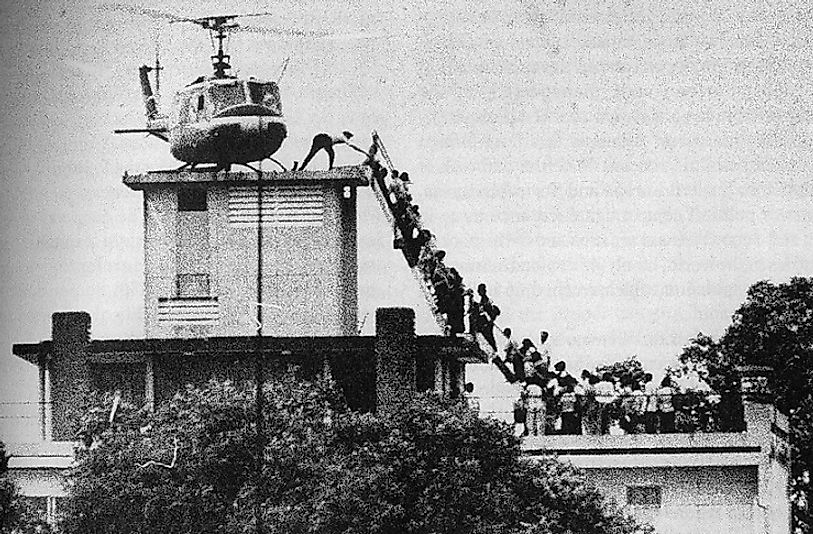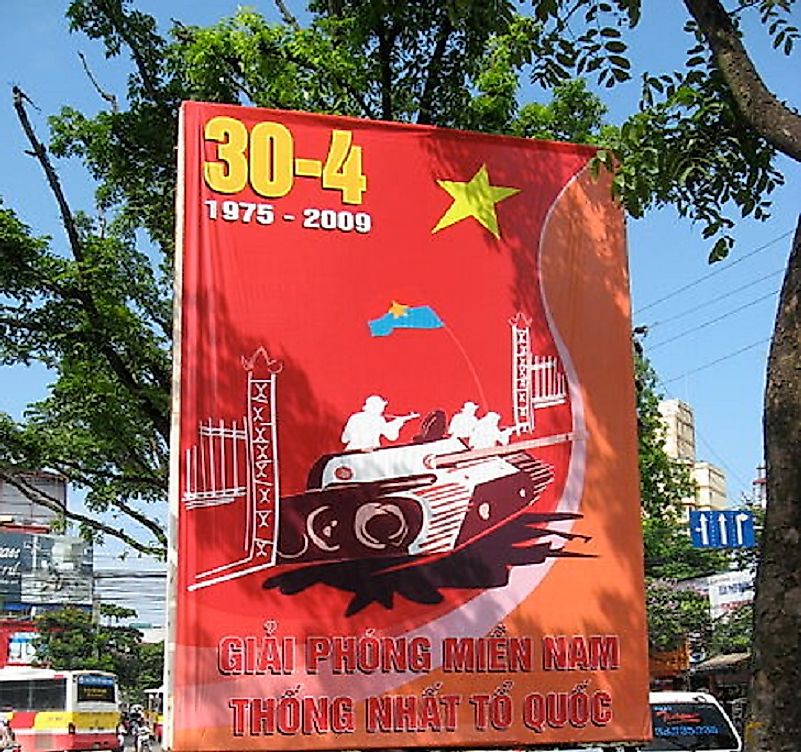The Fall Of Saigon - Vietnam War

5. Background
The Fall of Saigon was a series of events that took place across the last few days of April of 1975 as Saigon (the capital city of South Vietnam) was captured by North Vietnamese communist forces. It marked the very last events of the Vietnamese War which had been dragging on for close to twenty years. In early March of that year, North Vietnamese forces attacked the highlands just north of the city of Saigon. As the Northern forces started bombarding the city's international airport on April 28th, U.S. President Gerald Ford ordered Operation Frequent Wind, the largest helicopter airlift of all time, to rescue American civilians and military personnel, as well as South Vietnamese civilians by the thousands.
4. Makeup
As Vietnamese War drew to a close, the Northern Forces comprising the People's Army of Vietnam (PAVN) and the Viet Cong had a combined military strength of 120,000. To the South, the Army of the Republic of Vietnam (ARVN) under the leadership of Brigadier General Tran Van Hai had about 31,000 troops. Responsibility for defending the city of Saigon rested on Quan Doan III (III Corps) under the leadership of Nguyen Van Toan.
3. Description
On April 8th, 1975, the politburo at Hanoi ordered the North Vietnamese People’s Army's General Van Tien Dung to proceed with an aggressive advance full on to the city of Saigon. It was a big turnaround considering that barely a month before the politburo had urged Van Tien to exercise caution. By April 27th, the North Vietnamese People’s Army had encircled Saigon with well over 100,000 troops positioned all around the city. As early as late March, the fall of Saigon looked to be eminent and Americans were already leaving. Throughout April, the pace of evacuation picked up and all flights from the city were fully booked. General Toan had put in place five centers of defense for the city. However, these were poorly organized and could not withstand the North Vietnamese People’s Army and Viet Cong onslaught. Nguyen Van Thie, the President of South Vietnam, had already resigned on April 21st, delivering a scathing attack on Americans over what he perceived as the failure to offer help when it was most needed.
With Saigon's defense forces in complete disarray and the regime in utter collapse, General Tran tendered his resignation on April 28th. He was succeeded by Duong Van Minh. By the morning of April 30th, Dung had received full commands to take over power in Saigon. He ordered his commanders to advance to key installations within the city. At 10:24 that morning, Minh made an announcement of unconditional surrender, inviting the North Vietnamese People’s Army commanders to begin the process of a peaceful transfer of power. However, General Dung was not interested in any form of peaceful negotiation. By noon, North Vietnamese People’s Army tanks had pushed their way into Saigon's Independence Palace, and Minh was taken captive.
2. Outcome
The Fall of Saigon culminated in a decisive victory by the North Vietnamese People’s Army, as well as their Viet Cong backers. There are no exact figures about any casualties, though South Vietnamese forces capitulated quickly. However, as the Tan San Nhut Airport was heavily bombarded by Northern forces on the 29th of April two American servicemen, Darwin Judge and Charles McMahon, were killed. They were the last American troops to lose their lives in the Vietnamese War.
1. Significance

Immediately after taking over Saigon, the new communist regime changed Saigon's name to Ho Chi Minh City, renaming it after the former president of North Vietnam. Even if the massive evacuation effort had led to many people leaving the city, the new regime was determined to relocate about 1.5 million others in a bid to decongest the city as it had experienced a massive population influx over the course of the wartime years. Records show that within two years after hostilities ceased, well over a million people had been relocated from the city.
April 30th has been named, and celebrated as, Liberation Day (Ngay Giai Phong) or Reunification Day in the country, even though the formal reunification of the two Vietnamese states did not take place until July 2nd, 1976. Today, the day is commemorated with a flourish of patriotic pageantry around Vietnam. Workers receive two days off extending into May 1st (coinciding with May Day, which is a special celebration of workers, especially among Socialists, all over the world). For the Southern Vietnamese expatriates, mainly in the U.S.A., the last week of April is known as “Black April”. They take time to lament the fall of Saigon, and the abandonment of their American allies. Today, the Socialist Republic of Vietnam is one of only four one-party socialist states in the world.











